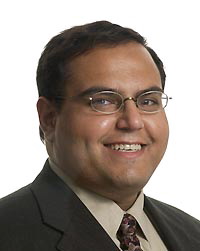|
This is an archived article.
For the latest news, go to the Advance
Homepage
For more archives, go to the Advance Archive/Search Page. | ||
|
New
Treatment Offered for Seizures
A new procedure to reduce the number and duration of seizures in people with severe epilepsy is now being performed at the Health Center.
The procedure, called vagus nerve stimulation, involves the surgical implantation of a small stopwatch-sized device in the chest. Wires from the device are tunneled under the skin to the left vagus nerve in the neck, which affects the areas of the brain known to be responsible for seizures. The wires deliver regular, pre-programmed electrical stimulation 24 hours a day to the nerve. "It's like a pacemaker for the brain," says Ahmed Khan, assistant professor of neurosurgery, the only surgeon in the area performing the procedure. "The intermittent electrical pulses decrease the number of seizures in most patients," he says. In addition to the regular stimulation programmed by the physician, the patient can pass a special magnet over the device, triggering additional stimulation. The action can end a seizure or decrease its severity. Epilepsy is a neurological disorder characterized by seizures or sudden losses of consciousness. It is one of the most prevalent neurological disorders in the country, affecting about 0.5 percent of Americans. About 20 percent of those living with epilepsy are unable to control their seizures with medication. "Uncontrolled seizures make it extremely difficult to live a normal life," says Dr. Khan. "It's hard to maintain a job, go to school, drive a car or perform many of the other routine activities most of us take for granted." Khan says that on average, 30 to 40 percent of people with the VNS device have about a 50 percent reduction in the number of their seizures. "That's about as good as many of the new medications recently released to treat epilepsy," he adds. "The advantage of VNS is that it avoids the cognitive blunting that comes with the use of many anti-epileptic medications." The device, called the NeuroCybernetic Prosthesis, is made by Cyberonics of Houston, Texas, a company that designs, develops and markets medical devices for the treatment of epilepsy and other disorders using vagus nerve stimulation therapy. The procedure was approved by the Food and Drug Administration in 1997 for use on adults and adolescents over 12 years of age with seizures that don't respond to medical treatments. The device has been used on more than 14,000 patients worldwide. Kristina Goodnough |

